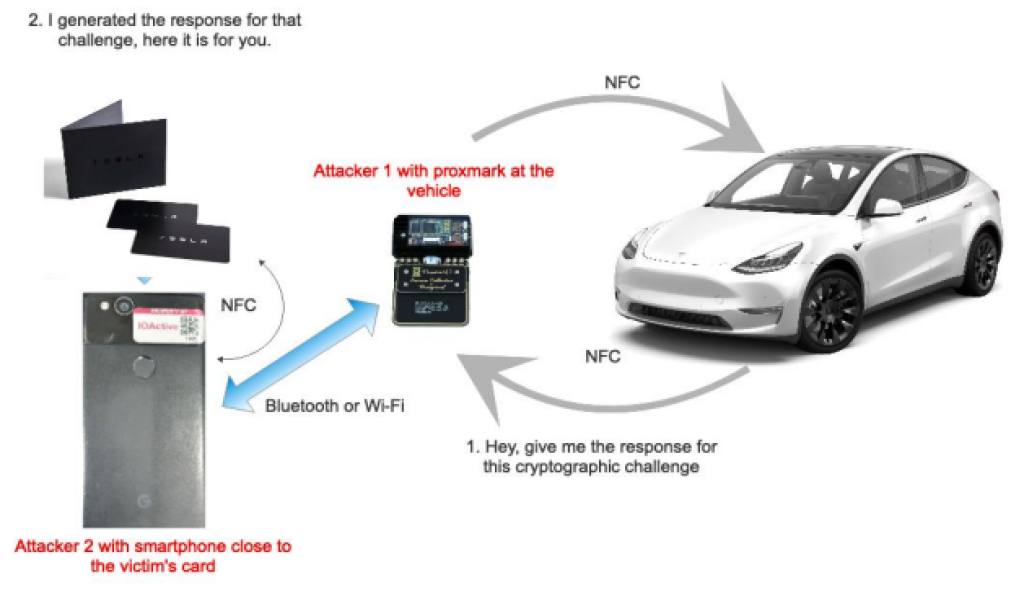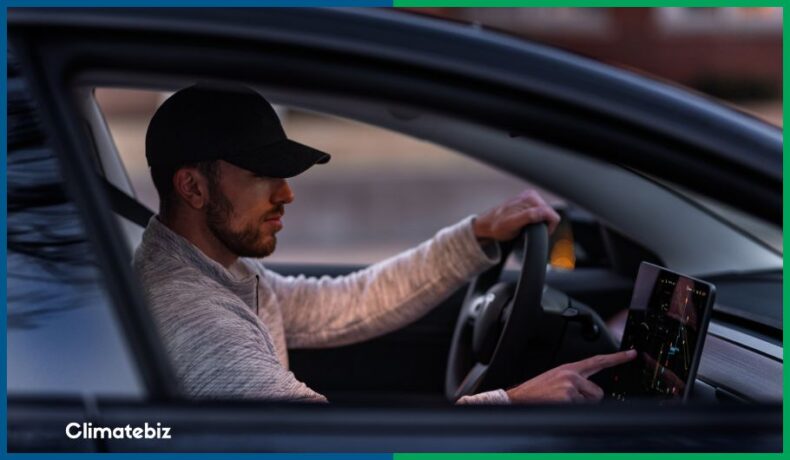Tesla may be one of the most technologically advanced car brands today, but that doesn’t mean their vehicles are immune to theft.
These electric vehicles (EVs) are sleek, stylish, and packed with high-tech features that make them a joy to drive.
Unfortunately, all that luxury gives criminals plenty of incentive to try their hand at stealing one.
In this article, we discuss whether a Tesla can be stolen, outline its security features, and provide you with tips to help keep your precious EV safe from would-be criminals.
Table of Contents
Can a Tesla be stolen?
A relatively new relay attack carried out by IOActive, revealed that Tesla EVs can be stolen. The hack itself is quick, but carrying it out is easier said than done.
Security researchers from the company successfully revere-engineered Tesla’s near-field communication (NFC) protocol. In doing so, they were able to steal a Tesla Model Y.
The process requires at least two people to carry out the theft. Once the Tesla owner has left their vehicle, the criminal must follow them very closely and get within two inches of their smartphone or keycard. Meanwhile, the second person must stand near the car to relay the signal and open the vehicle.
Can Teslas Be Stolen Without A Key?
Unfortunately, the nature of a relay attack means that criminals can carry it out without needing a key.
Can a Tesla be hacked?
IOActive has demonstrated that a Tesla is susceptible to theft — it’s possible to hack these EVs using relay attacks. But what goes into such an attack?
As previously mentioned, IOActive was able to reverse-engineer the NFC protocol that Tesla uses between the NFC card and the vehicle.
They then created custom firmware for a Proxmark RDV4.0 device to relay NFC communications via Wi-FI/Bluetooth using the Proxmark’s BlueShark module.
What is the Proxmark?
The Proxmark is a general-purpose radio frequency identification (RFID) tool that people — and, unfortunately, criminals — can use to listen to and mimic everything from low-frequency (125kHz) to high-frequency (12.56MHz) tags.

Source: IOActive White Paper NFC Relay Attack On Tesla Model Y
What does a relay attack require?
This type of attack relays cryptographic material between the EV and the virtual key (NFC card or smartphone).
IOActive’s white paper discusses their NFC relay attack on the Tesla Model Y:
“This relay attack requires two attackers; in this case, one of the attackers will be using the Proxmark device at the vehicle’s NFC reader, and the other can use any NFC-capable device (such as a tablet, computer, or for the purposes of this example, a smartphone) close to either the victim’s Tesla NFC card or smartphone with the Tesla virtual key. “
The Proxmark and the second criminal’s smartphone communicate via Wi-Fi or Bluetooth using the BlueShark module. The Proxmark links to a small computer like the Raspberry Pi with Bluetooth while the computer connects to the second attacker’s smartphone via Wi-Fi.
The following image illustrates the above process:

Are Tesla’s easy to steal?
At this stage, you may be worried that it’s easy for criminals to steal your beloved Tesla.
While Tesla theft using relay attacks is possible, it isn’t exactly easy to carry out.
For starters, criminals must be able to access the devices necessary to perform the theft. Then, they need the knowledge to put it all together.
More importantly, the thieves must get their device within extremely close range (two inches) of your key card or phone. Attempting this is risky and could raise alarm bells.
Relay attacks aren’t foolproof
Tesla is no pushover — while relay attacks pose a threat, carjackers may have to jump through additional hoops to make off with your vehicle.
The car manufacturer understands that its EVs are in demand on the black market, so it’s made sure to add intelligent security features to offset the risk of theft.
Do Teslas have anti-theft?

Tesla isn’t going to let criminals walk away with your investment without a fight. The company has added several critical security features to its EVs. Here are the anti-theft features that come with each Tesla:
Pin to drive
Pin to drive is probably your greatest weapon against any form of Tesla theft, including relay attacks. This feature allows you to set a secure four-digit code that you must enter before driving your vehicle.
So even if a criminal is able to access the inside of your car, they won’t be able to drive away with it.
Sentry mode
Sentry mode helps you look for suspicious activities around your Tesla when it’s parked and locked. When the car detects suspicious behavior, it’ll react according to the threat level.
For instance, if a criminal starts acting suspiciously around your vehicle, its cameras will begin recording, and the alarm system will kick in. Additionally, the Tesla app will notify you that an incident has taken place.
Security alarm
An industry standard. If your vehicle’s door or trunk has been opened without a valid entry key, its alarm will sound, and external lights will start to flash.
Any kind of alarm will raise a red flag and cause the person in question to stand out like a sore thumb.
Manual entry
Enabling passive entry on the Model X and Model S will automatically unlock your EVs doors as soon as you approach with your key fob. Meanwhile, the Model 3 uses an authenticated phone key combined with a Bluetooth signal to unlock your vehicle’s doors as you approach.
While this sounds snazzy, it puts both you and your car at risk, especially at night. So it’s in your best interest to disable passive entry and require a key to enter your vehicle.
Intrusion sensors
All new Tesla vehicles come with intrusion-detection hardware. Tesla states that other vehicle trims — likely older models — will have these systems activated via future updates.
How to prevent your Tesla from being stolen
While a Tesla comes with a myriad of security features to stop theft, there are other methods you can use to ensure that your EV remains in your possession.
- Improve your home security.
- Purchase a faraday bag/pouch.
- Invest in a secondary GPS tracker.
- Update your Tesla regularly.
- Enable Pin to drive.
- Disable passive entry.
- Choose your parking spot wisely.
- Purchase a mechanical steering wheel lock.
- Enable sentry mode.
- Don’t leave your keys lying around.
1. Improve your home security
While Teslas come with handy anti-theft features, you can put additional measures in place to prevent thieves from gaining access to your vehicle on your property.
- Park your Tesla behind an obstacle. Ideally, behind a secure gate or in a garage.
- Install CCTV cameras around the outside of your property.
- Invest in bright outdoor floodlights.
- Purchase alarm sensors.
2. Purchase a faraday bag/pouch
Faraday bags/pouches adhere to the same principles as a faraday cage. These objects are made of a conductive metal material that prevents wireless signals from contacting your devices.

Once you’ve exited your Tesla, place your smartphone, key fob, or key card into one of these bags/pouches to prevent relay attacks.
3. Invest in a secondary GPS tracker
Thieves may not count on having installed an additional tracker in your EV. A secondary GPS tracker coupled with a quality tracking service will help you hunt down your Tesla should it be stolen.
4. Update your Tesla regularly
Software updates go a long way toward protecting smartphones and PCs from hackers. The same goes for Teslas. So make sure you regularly update your vehicle’s software.
5. Enable PIN to drive
You wouldn’t leave your phone lying around without a secure PIN code, would you? Now imagine making the same mistake with a $135,990 Model S Plaid.
Whatever the circumstances, having a PIN as a last line of defense is an absolute must.
6. Disable passive entry
Being able to walk up to your Tesla and have it open automatically may make you feel like James Bond, but you won’t feel like a million bucks when someone swoops in to rob you and steal your car.
Disable passive entry as soon as possible to avoid such scenarios, especially at night.
7. Choose your parking spot wisely
The difference between someone attempting to steal your Tesla and leaving it alone often comes down to where you park it.
No matter where you are or what time of day, make sure you park your car in a well-lit area that’s visible to as many people as possible.
Criminals like to go for soft targets — they’ll avoid cars in areas with a lot of traffic and are easy to spot.
8. Purchase a mechanical steering wheel lock
This method may seem a tad old-school, but it’s incredibly effective, especially for anyone who leaves their vehicle in a potentially vulnerable position for an extended period.

View on Amazon
What’s more, it adds an additional deterrent visible to the criminal. This could stop them from even attempting to break into your car.
9. Enable sentry mode
As previously mentioned, sentry mode is a useful anti-theft feature that helps you keep tabs on your Tesla, whether at home or out and about.
Enabling this mode will allow your Tesla to monitor any questionable behavior around your vehicle.
In the event that your vehicle does pick up suspicious activity, it’ll begin recording, set off the alarm, and alert you via your app.
10. Don’t leave your keys lying around
Last but not least, the most common sense piece of advice we can give you is to store your keys in a safe place. Preferably on you when you’re out and somewhere secure at home.
Whatever you do, don’t leave keys lying around.
Ultimately
A multilayered approach to security is the best way to combat Tesla theft. You may have to fork out some extra cash for some of these methods, but it’ll be worth it. After all, Teslas are an expensive investment.
What happens if someone steals my Tesla?
As with any instance of car theft, your best bet is to contact your local police force immediately.
If your phone is on you, use the Tesla App to locate your vehicle and send this information to the police until they manage to apprehend the thieves.
In addition to the above, you can use your phone to set a maximum speed limit. This will help officers chase your vehicle down. So, you could set its max speed to 50mph if it gets stolen.
Moreover, you can remotely honk the horn and flash the headlights to indicate that an active theft is in progress.
Final thoughts
While Tesla EVs have been the victim of hacking and theft, with methods such as relay attacks, the company continues to make great strides to ensure that its vehicles remain in their owners’ hands.
These high-tech machines come at a considerable cost, so if you’re serious about protecting your Tesla from criminals, we suggest you establish a robust, multilayered approach to security.
We hope that you found these tips helpful. Should you have any further tips of your own, feel free to share them with us via Twitter or in the comments section below.

